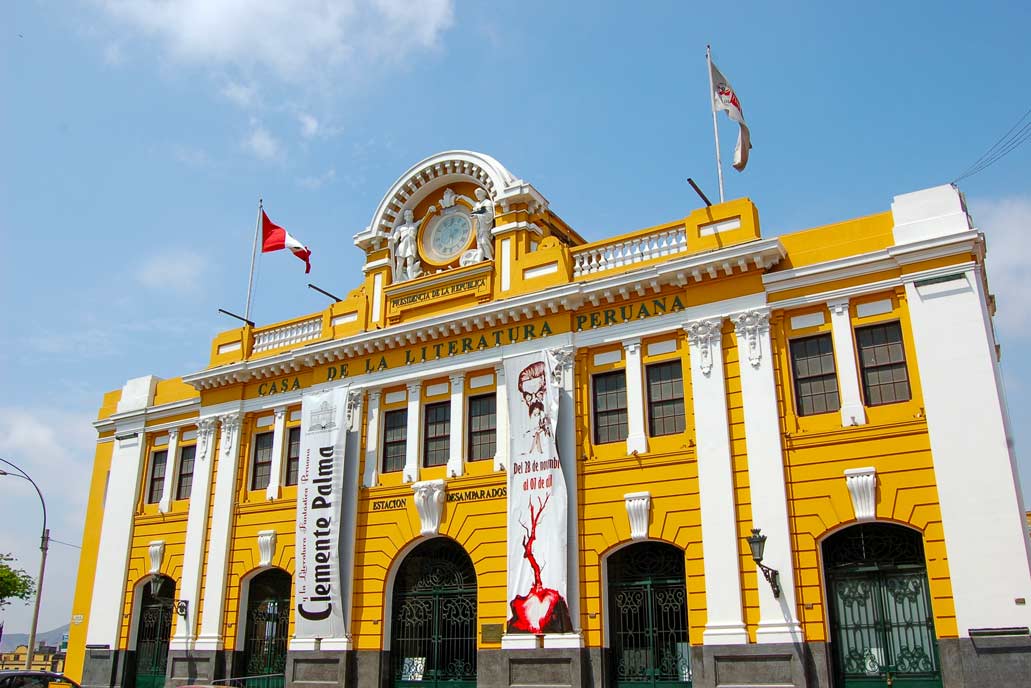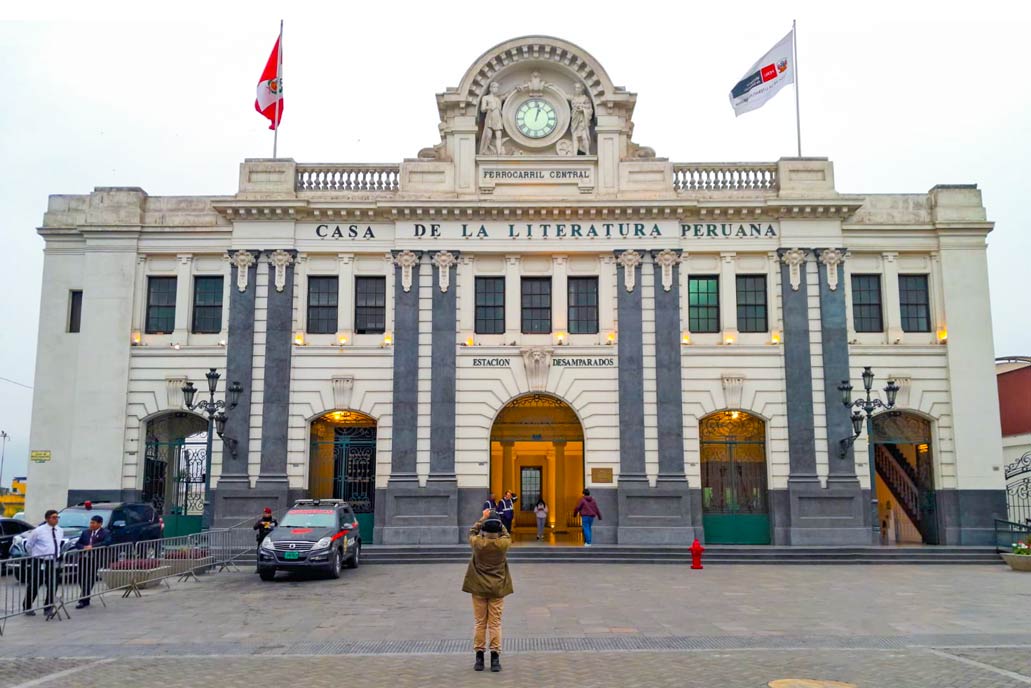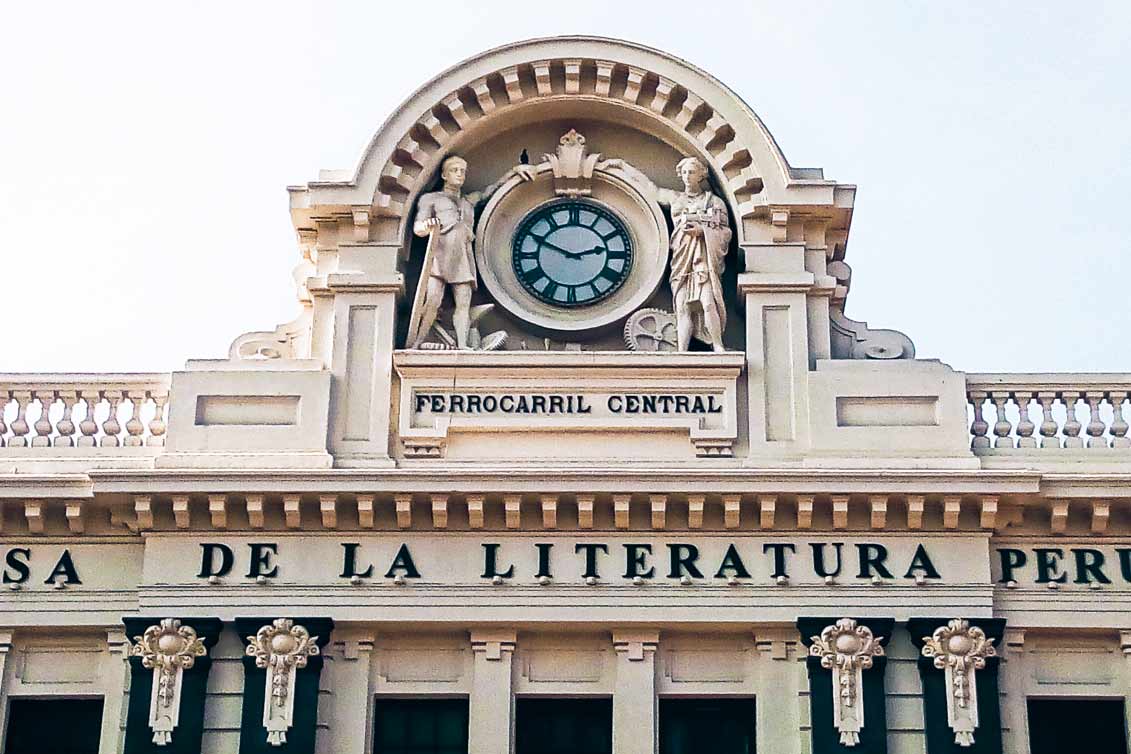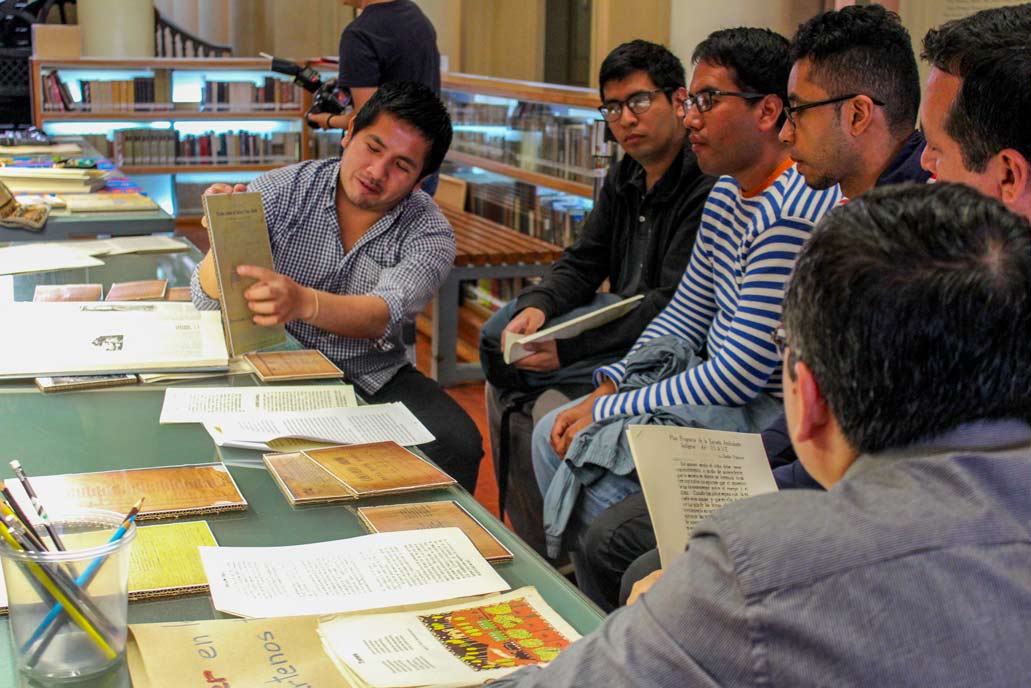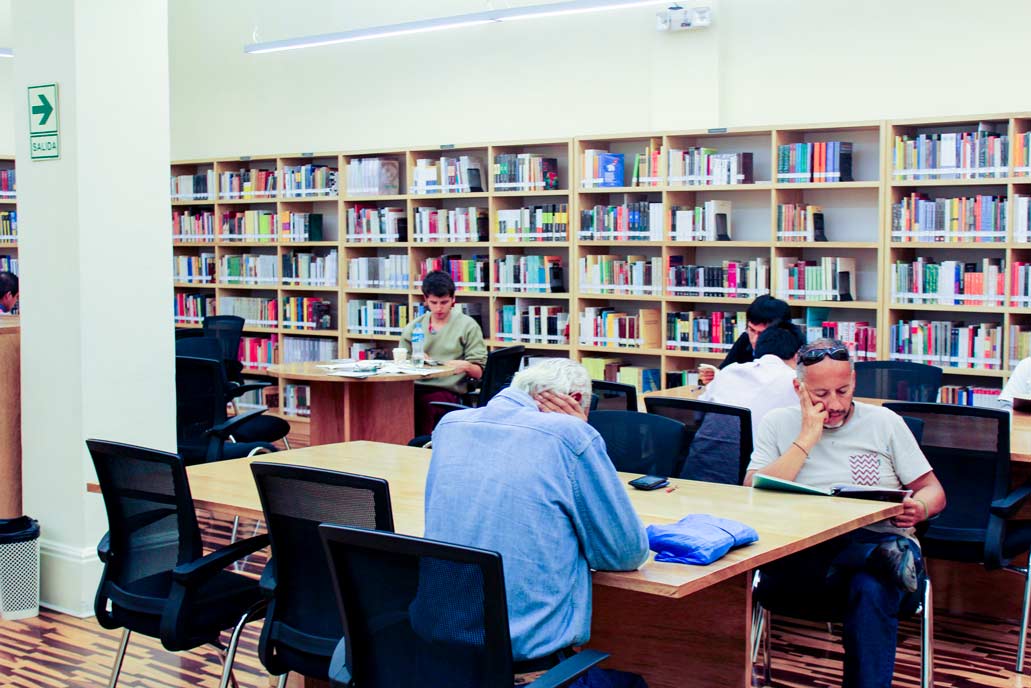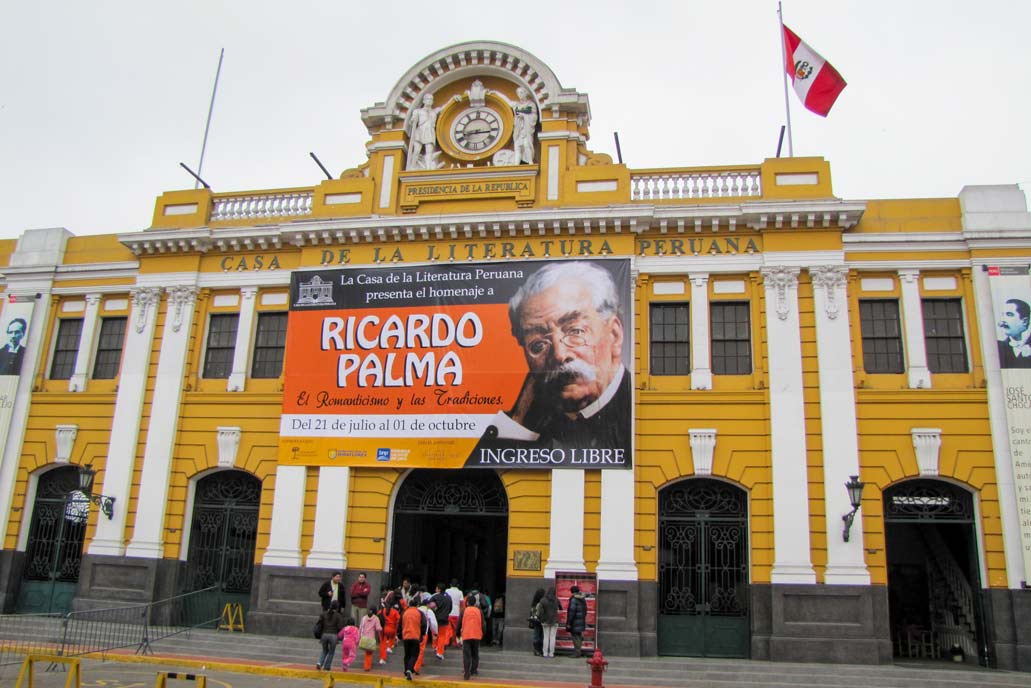5 Reasons to Visit the Peruvian House of Literature in Lima
At the end of 2009, this important cultural space was inaugurated. It features impressive architecture, and not only that, but visitors can also enjoy a warm environment dedicated to the vast world of Peruvian literature. Built on an old train station, it houses a library with more than 20,000 books. Most notably, it has spaces dedicated to children and interactive rooms.
Table of Contents
1. History of the Peruvian House of Literature
Before becoming a building dedicated to literature, it was an old train station. Its name at the time was Estación Desamparados, located very close to the Rímac River, on Jirón Áncash next to the Government Palace. It was named so because, until 1937, there was a Jesuit temple and convent near the site known as Nuestra Señora de los Desamparados. The old train station, which had routes to the Peruvian Andes, was built in 1870. The building we see today was constructed over this foundation.
Eleven years later, Peru entered into armed conflicts with Chile. The Chilean army took control of Lima, causing irregular train operations, with only three trips per week being permitted. After the war, with the Peruvian state facing financial debts and economic struggles, the station was leased to The Peruvian Corporation Limited for 65 years.
As Lima’s population grew and the railway station became the only company capable of traveling to the country’s interior, efforts were made to modernize the station. It was considered the first modern building in the city. The railway company requested an elegant construction, a task entrusted to architect Rafael Marquina. After his training in the United States, he presented a design with French neoclassical art finishes, which we can still admire today.
The Nuestra Señora de los Desamparados temple and convent has its own history. In 1630, it was originally built as a chapel, serving as a burial site for unclaimed bodies. By 1767, it had become a temple and convent under the same name, later functioning as a seminary until Peru’s independence.
It remained operational until ENAFER ceased to exist. ENAFER took over the station during the military government from 1968 to 1980. However, in 1972, there was an attempt to demolish it to expand the Rímac River boardwalk. In response, that same year, it was declared a National Monument. Over time, it came under the Ministry of Education, which closed its doors until 2003, when it was renamed the Estación Desamparados Educational and Cultural Center.
Finally, following this cultural initiative, Supreme Decree 007-2008 was issued in 2008. This decree officially named Estación Desamparados as the new Peruvian House of Literature. Following this decree, the Ministry of Transport loaned the building to the Ministry of Education. The House of Literature has been operating since October 20, 2009, under the administration of the Ministry of Education.
In the project led by Rafael Marquina, the concrete used for the columns and walls, as well as the stained glass windows and the clock, were imported from England. Meanwhile, the solid cedar doors were brought from the United States.
2. Impressive Architecture
This building was primarily designed by architect Rafael Marquina. Construction was completed in 1912. The purpose of this building was to provide a central office for the railway company. At that time, the railway connected the city of Lima with Pasco, in the central region of Peru. To build this important social center, modern materials and methods were used. In this regard, reinforced concrete with iron structures and wire mesh frames were adopted.
The facade features large paired Doric pilasters. These are accompanied by elements such as finely carved ashlar rustication. The pilasters and baseboards have plinth-style decorations, enhancing their pedestal-like function across the facade. They contrast with the grand architectural orders that emphasize the height of the main entrance. At the top, right above the entire facade, there is a monumental clock adorned with neo-Baroque artistic details.
The building has three levels. Inside, there is a central atrium extending from the basement to the second floor. It boasts spectacular details in the staircases, balconies, and interior columns. Upon entering the Peruvian House of Literature, visitors immediately notice a change in atmosphere. Leaving behind the congestion of downtown Lima, they step into a peaceful and elegant space that uplifts the spirit of any visitor.
3. Permanent Exhibitions
Visitors to the Peruvian House of Literature can enjoy a permanent exhibition, which is highly popular and recommended for literature enthusiasts. The exhibition “Intensity and Height of Peruvian Literature” is displayed in six rooms. This initiative showcases literary works that reflect the various identities within Peru.
The exhibition is structured around thematic axes that serve as a link to express the literary process related to identity. The first axis is “Woven Voices,” which explores Peru’s cultural and linguistic diversity. This diversity stems from the country’s 47 different languages. The exhibition highlights the presence of many bilingual speakers in Peru. Additionally, it emphasizes the variations of Spanish spoken in different regions, demonstrating the diverse expressions and evolving cultural narratives of the country.
This first section provides a glimpse into the various ways of life in Peru. These are depicted through images, stories, songs, and poems in each of the languages spoken in the country. This initial segment is essential as it introduces visitors to the vast literary expressions found within Peru alone.
The second section, “Conflicts: The Desire for a Voice,” explores nearly 500 years of encounters between two worlds—two cultures that ultimately led to a new cultural process. From this encounter, written tradition was introduced, beginning with the infamous meeting between Atahualpa and Pizarro. Initially, Spanish chroniclers dominated the narratives.
However, later, as the first mestizo chroniclers emerged to tell the history of ancient Peru, their versions often conflicted with the accounts of the victors. This marked the rise of new voices eager to tell their own stories. This section showcases memoirs, different versions of historical events, and various legends. The goal is to highlight alternative perspectives and provide a deeper understanding of this globally significant historical event.
Finally, the third section, “Kay Pacha,” presents a chronological compilation of historical and literary events. It offers insights into various encounters and viewpoints from over 4,000 years of Peruvian history. This section also ties together the themes explored in the previous sections.
4. Various Libraries
Since its founding in 2009, the Peruvian House of Literature has offered three spaces dedicated to reading. The first is the Mario Vargas Llosa Library, the second is the Cota Carvallo Children’s Literature Room, and the Literary Café. These services are completely free for people of all ages and backgrounds. It is not an exclusive place for academics or literature students. The institution’s main goal is to provide a reading space with all necessary resources.
Services are provided by mediators who guide and assist visitors in their searches. It is essential that the motivation and environment are suitable so that visitors are encouraged to return. The team is constantly updated and trained for these functions.
Libraries, in general, play a vital role in any institution, district, or region. A well-designed reading space fosters a reading habit, a spirit of reflection, a need for research, and, consequently, an exchange of ideas. All of this benefits not only avid readers but also contributes to adequate social development.
In this sense, the reading spaces of the Peruvian House of Literature are highly significant and promote various activities. Programs showcase different expressions of Peruvian and world literature. Every year, reading materials and book catalogs are updated. All of this aims to strengthen and contribute to a reading and critical-thinking society. Let’s explore some details of these three services.
- The Peruvian House of Literature is located at Jr. Ancash 207 in the historic center of Lima.
- Opening hours are Tuesday to Sunday from 10:00 AM to 7:00 PM. The rooms have their respective schedules.
Mario Vargas Llosa Library
This library mainly houses specialized literature on Peruvian literature. It contains national and international publications, including books and magazines. The library holds more than nine thousand titles and fourteen thousand copies from various collections and publishers. Electronic versions are also available.
It offers two reading areas. The first is the main library, where texts by the renowned Peruvian writer Mario Vargas Llosa can be found. A catalog of studies dedicated to his work is available, featuring articles and books. Additionally, it holds interdisciplinary collections in anthropology, history, philosophy, and art. There are also special collections such as comics, graphic novels, book objects, and some publications by the Peruvian House of Literature.
The other space is more specialized and is known as the Researchers’ Room. This section contains literary criticism and studies dedicated to literature. It also features an exclusive collection of José María Arguedas, used primarily for reading mediation and literacy instruction. Another specialized academic collection includes antique books, newspaper publications related to literary events, and audiovisual materials.
Following the pandemic, new services were introduced. Visitors can now access virtual assistance through “Your Online Librarian,” which provides consultations on literature, reading mediation, and humanities. This service is available through the Peruvian House of Literature website.
Before the health emergency, the following activities were offered: book and magazine exchange events, training workshops, reading sessions, film forums, literary discussions, and access to books and shelves with a national ID. While some activities are still pending return, others are now conducted virtually or in different locations. All activities can be accessed through the institution’s website and Facebook page.
Opening hours are Tuesday to Sunday from 10:00 AM to 7:00 PM. It is also important to note that exhibitions and rooms may change depending on the season or special recognitions. Some rooms may be temporarily modified to accommodate these events.
Cota Carvallo Children’s Literature Room
This space is dedicated to children’s literature and is open to children, teenagers, and adults interested in this artistic expression. The room features open bookshelves and is also free to access. Its main collections include:
- El pájaro niño: A collection of illustrated books designed for young children due to their simple readability.
- Oshta y el duende: Books that narrate folk tales and legends, showcasing Peru’s vast mythology.
- Rutsi, el pequeño alucinado: A collection of more complex and varied narratives, fostering deeper reading engagement for young readers.
- La flor del tiempo: Texts that provide a historical overview, characterized by informative and encyclopedic books.
Schools and educational institutions can schedule guided tours of the room and its services. Reservations must be made in advance through the institution’s website.
Mediators are responsible for sharing and guiding readings when necessary. They also assist families in fostering a proper reading habit. This team, consisting of both men and women, also organizes storytelling activities, baby libraries, summer workshops, outdoor reading sessions, book-of-the-month discussions, and family reading activities.
- Opening hours: Tuesday to Friday from 10:00 AM to 5:00 PM. Saturdays and Sundays from 10:00 AM to 6:00 PM.
Literary Café
The main function of this space is to serve as a meeting point for readers. Visitors can find short texts, such as brief narratives, comics, literary magazines, newspapers, poetry collections, and more. Additionally, users are welcome to bring their own books and materials to enhance their reading experience.
This space is also considered a tourist attraction, as some remnants of the old Desamparados Station can still be found. A particularly gratifying feature is its spectacular view of the Parque de la Muralla, where visitors can hear the murmur of the Rímac River and see Cerro San Cristóbal, the site of a battle between the resistance of the Incas of Vilcabamba and reinforcements sent by Pizarro to Cusco.
On certain dates, collective reading activities for selected texts are held. Experts in the field are invited to participate in open discussions with attendees. Reservations and confirmations are required through the institution’s website. These events are sporadic and aim to encourage academic reading.
- Opening hours: Tuesday to Sunday from 10:00 AM to 7:00 PM.
5. Important Events
The Peruvian House of Literature hosts various activities, all of which are, of course, related to literature. Additionally, it promotes spaces for reflection and dialogue in the auditoriums within its facilities. These auditoriums are used for book presentations, national and international congresses, and even theatrical performances.
Another important service provided by this institution is access to an online catalog of all its books. This feature makes it easier for readers to search for titles, allowing them to visit the library with the confidence of finding what they need. The virtual library also offers a wide range of e-books, featuring valuable and relevant readings for all audiences.
The institution also encourages the publication of texts from various literary genres. Among the publications available at the Peruvian House of Literature, readers can find comics, poetry and narrative studies, essays, book objects, historical literature, children’s books, and catalogs of exhibitions held throughout the institution’s more than ten years of service.
Since June 26, 2021, some in-person services have been reopened. One of the most important was the Home Book Loan Service, which is available exclusively to primary and secondary school teachers, as well as higher education researchers. Other lending services include children’s library books for families and reading guides. If you are exploring the historic center of Lima, the Peruvian House of Literature should definitely be on your itinerary.
By Machupicchu Terra – Last updated, February 15, 2025
